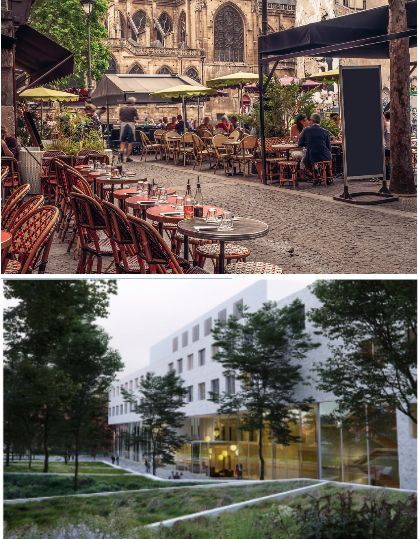PhD position
posted on November 4, 2022
PhD position: Neural bases of the facial imitation of auditory smiles in health, epilepsy and coma (EEG, SEEG).
Application deadline: Dec 9th, 2022
Start date: February-March, 2023
The Institut Psychiatrie & Neurosciences de Paris (IPNP) and the Femto Neuro group are seeking applicants for a fully-funded PhD position (3 years), to be held in Pr Guillaume TURC’s team, IPNP in Paris, France.
The position is funded by INSERM, with the support of French Agence Nationale de la Recherche, for a project seeking to explore the neural (phonological, sensorimotor and semantic) bases of facial imitation in response to smiled speech, in both healthy participants, patients with refractory epilepsy, and coma patients. It provides an exciting opportunity for interdisciplinary research training in data-driven and experimental methods in cognitive and clinical neuroscience.
The position is based at the IPNP Institute in Paris, France, on the campus of the GHU Paris Psychiatrie & Neurosciences (Hôpital Sainte-Anne) and will be co-supervised by Dr Anais Llorens (IPNP), Prof. Martine Gavaret and Prof. Tarek Sharshar (GHU/IPNP), and Dr Jean-Julien Aucouturier (FEMTO-ST, Besançon).
The science
Our recent research has shown that participants who listen to smiled speech (speech that was pronounced while smiling) respond to it with unconscious facial imitation (Arias et al., Current Biology 2018). This behaviour suggests a complex form of cognitive processing involving the phonological recognition of the spectral signature of smiled speech, the activation of sensorimotor networks linking this signature with oro-facial motor activity and, perhaps, the involvement of social-cognitive and emotional circuits linked to social communication. However, the exact neural bases of unconscious facial imitation of smiled speech remain largely unknown.

Figure: Acoustic, behavioral and electrophysiological consequences of auditory smiles. A: Smiling while speaking increases the frequency of the first two local resonances (or formants) of the spectral envelope. B: This modified spectral signature affects how listeners rate expressions involving stretched/contracted lips, such as joy or sadness, but has no effect on the recognition of emotions involving other mouth shapes, such as surprise C: Listeners of smiled and unsmiled spoken sentences spontaneously responded with both increased zygomatic and decreased corrugator activity, as measured with facial electromyography (EMG). Further data (not shown here, see Arias et al. Current Biology 2018; Current Bioloy 2021) showed that this imitative behaviour was independent from participants’ subjective reports of smiliness, i.e. that it was partly unconscious. Figure adapted from Arias et al. 2018..
Clarifying the extent towards which unconscious facial imitation reflects reflex sensorimotor processing or genuine social communication is important both theoretically, because it offers a window into covert auditory processing in unconscious states, and clinically, because the “smiled speech” test could then be used to probe the depth of remaining consciousness in comatose ICU patients (Fiacconi & Owen, 2016).
This PhD project consists in exploring the neural bases underlying the conscious and unconscious facial imitation of smiled speech. The successful applicant will, first, conduct EEG/EMG experiments with healthy participants, as well as intracranial (SEEG) experiments with epilepsy patients (Mercier et al. Neuroimage 2022), using a data-driven paradigm allowing the systematic manipulation of acoustic cues in speech stimuli (reverse-correlation, Ponsot et al. JASA 2018). Next, the project will consider the opportunity to use facial imitation in response to smiled speech stimuli as an evaluation of consciousness for comatose patients, in collaboration with the GHU Neuro-ICU department hosting the project.
The PhD project thus provides an exciting opportunity for a data-intensive exploration of several neurophysiology modalities (EMG, EEG, SEEG), addressing rich theoretical questions about language processing, consciousness and social cognition, as well as a highly-critical clinical application in the context of coma science.
Arias, P., Belin, P. & Aucouturier, JJ (2018) Auditory smiles trigger unconscious facial imitations. Current Biology. Vol. 28 (4), PR782-R783
Ponsot, E., Arias, P. & Aucouturier, JJ (2018) Uncovering mental representations of smiled speech using reverse correlation Journal of the Acoustical Society of America, vol 143 (1).
Fiacconi, C. M., & Owen, A. M. (2016). Using facial electromyography to detect preserved emotional processing in disorders of consciousness: A proof-of-principle study. Clinical Neurophysiology, 127(9), 3000-3006.
Mercier, M. R., Dubarry, A. S., Tadel, F., Avanzini, P., Axmacher, N., Cellier, D., … & Oostenveld, R. (2022). Advances in human intracranial electroencephalography research, guidelines and good practices. NeuroImage, 119438.
The environment
The successful applicant will join a small, recently-established interdisciplinary group of scientists, distributed on two research sites (IPNP/GHU in Paris, FEMTO-ST Institute in Besançon) who explore new data-driven approaches to the analysis of sensory electrophysiology, with an application to coma. The applicant will be based primarily in IPNP, Paris, but will have numerous opportunities to interact with both teams.
 The Paris team, coordinated by Prof. Tarek Sharshar, M.D. (Dept. of Neurointensive care, IPNP/GHU) and Martine Gavaret, M.D. (Dept. of neurophysiology, IPNP/GHU), has a strong clinical orientation, with expertise in neurophysiological assessment, SEEG signal processing, coma assessment and clinical trial management. It consists of two PhD students and one senior postdoctoral fellow, Dr Anais Llorens. IPNP (Institut de Psychiatrie et Neurosciences de Paris) (UMR1266, INSERM, Université de Paris) is a multi-disciplinary institute spanning all fields of molecular, cellular, cognitive and system neurosciences, with a translational focus on psychiatry and neurology problems. GHU (Groupement Hopitalo-Universitaire Paris Psychiatrie et Neurosciences), formerly Hôpital Sainte-Anne, is Paris’ first hospital for
mental health and neurology, employing over 600 medical doctors.
The Paris team, coordinated by Prof. Tarek Sharshar, M.D. (Dept. of Neurointensive care, IPNP/GHU) and Martine Gavaret, M.D. (Dept. of neurophysiology, IPNP/GHU), has a strong clinical orientation, with expertise in neurophysiological assessment, SEEG signal processing, coma assessment and clinical trial management. It consists of two PhD students and one senior postdoctoral fellow, Dr Anais Llorens. IPNP (Institut de Psychiatrie et Neurosciences de Paris) (UMR1266, INSERM, Université de Paris) is a multi-disciplinary institute spanning all fields of molecular, cellular, cognitive and system neurosciences, with a translational focus on psychiatry and neurology problems. GHU (Groupement Hopitalo-Universitaire Paris Psychiatrie et Neurosciences), formerly Hôpital Sainte-Anne, is Paris’ first hospital for
mental health and neurology, employing over 600 medical doctors.
 The Besançon team, coordinated by Dr Jean-Julien Aucouturier (Dept. of Automation & Robotics, FEMTO-ST Institute), has a strong methodological orientation, with expertise in data-driven methods and healthy participants EEG.. It consists of 3 PhD student, one postdoc and one permanent research scientist. The [FEMTO-ST Institute] (https://www.femto-st.fr/en) in Besançon (UMR6174, Université de Franche-Comté, CNRS, ENSMM, UTBM) is one of the country’s largest technological research unit, with 700 researchers spanning all fields of engineering and system science, and an internationally-recognized hub for health technology, incl. robotic medical devices, biomechanics and neuroscience
The Besançon team, coordinated by Dr Jean-Julien Aucouturier (Dept. of Automation & Robotics, FEMTO-ST Institute), has a strong methodological orientation, with expertise in data-driven methods and healthy participants EEG.. It consists of 3 PhD student, one postdoc and one permanent research scientist. The [FEMTO-ST Institute] (https://www.femto-st.fr/en) in Besançon (UMR6174, Université de Franche-Comté, CNRS, ENSMM, UTBM) is one of the country’s largest technological research unit, with 700 researchers spanning all fields of engineering and system science, and an internationally-recognized hub for health technology, incl. robotic medical devices, biomechanics and neuroscience
Applicants
The ideal applicant for this position holds a Master of Science (M2 Recherche) with a background either in computational modeling (e.g., data science, computer science, control engineering, applied mathematics) with an interest in neuroscience, or in experimental psychology/neuroscience with an interest in computational methods (e.g., computational neuroscience, psychophysical data modeling). Because of its clinical potential, this position could also be of interest for applicants holding a M.D. in Neurology or neurophysiology.
The project offers the best training potential for applicants who already have experience analysing experimental data (e.g. behavioural, psychophysical, electrophysiology or brain imaging data), and have a solid programming background in Python, R or Matlab. However, more than a formal background, drive is crucial for success in science, and a good number of past lab members have developed their computational skills only after joining the group. Clinical neurophysiology needs more quantitative scientists, and we also see it as part of our mission to educate the next generation of neuroscience practionners and professors in computational approaches.
Finally, to fully enjoy this project, the ideal applicant is also likely to have a specific interest in hearing science, sound perception, music, language & the brain and/or clinical applications in neurology.
How to apply:
Submit (1) a resume, (2) a cover letter (notably detailing the applicants’ experience in experimental data analysis) and (3) the name of 2 academic referees able to provide a recommendation (no reference letters are needed at this stage) by email to:
Dr Anais Llorens (anaisllorens@hotmail.com) and Dr Jean-Julien Aucouturier (aucouturier@gmail.com),
with the email object: « PhD SMILE + your name and first name ».
Application deadline: Dec 9th, 2022
Interviews for shortlisted candidates: Dec. 2022 - Jan. 2023
PhD start date: February-March, 2023